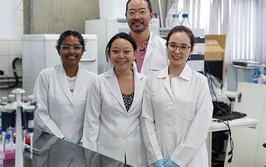Extraction and Analysis of PAHs from Grilled Hamburger

contributed by Supelco |
Introduction
Polynuclear aromatic hydrocarbons (PAHs) are compounds consisting of two or more fused aromatic rings. These compounds are lipophilic in nature, and are ubiquitous in the environment as a result of the incomplete combustion of organic matter. Those with five or more rings in their structure are usually referred to as “heavy” PAHs. These heavy PAHs are often the focus of toxicity studies, and some have been found to be carcinogenic and mutagenic.1 In the case of grilled meats, PAHs are formed and adhere to the meat when fat and juices come into contact with an open flame.2 In the United States, there are currently no guidelines regarding the consumption of foods containing PAHs,2 however in 2011 the European Union (EU) adopted regulation 835/2011 that established the maximum allowable levels in various foodstuffs. In heat treated meats, this maximum was set at 5 μg/kg of benzo[a]pyrene, and 30 μg/kg total as a sum of four PAHs: benzo[a]pyrene, benzo[a]anthracene, benzo[b]fluoranthene and chrysene.3
Since PAHs are lipophilic, extraction from fatty samples such as hamburger meat will subsequently co-extract a significant amount of matrix. If GC-MS analysis is used, fatty matrix will prematurely foul the inlet, column and detector. Backflush of heavy constituents can be used to prevent contamination of the GC column and detector, but it will not prevent residue buildup in the inlet liner. Consequently, sample cleanup is imperative if GC analysis is to be performed. Traditional methods of cleanup include gel permeation chromatography (GPC), and fractionation on large columns containing silica gel, alumina, or Florisil®. In this application, a simple extraction and cleanup method was developed for 28 different PAHs from grilled hamburger meat using the “Quick, Easy, Cheap, Effective, Rugged and Safe” (QuEChERS) approach. Subsequent cleanup was done using several different sorbents, including new zirconia-based Z-Sep and Z-Sep+ materials. Analysis was performed by GC-MS in selected ion mode (SIM) using an SPB®-608 capillary column. This column provided the selectivity and efficiency necessary to resolve several isomeric sets, including benzo[b], [j] and [k] fluoranthene. A shorter, narrow-bore dimension was chosen to reduce analysis time while maintaining high efficiency.
Log in or register to read this article in full and gain access to The Analytical Scientist’s entire content archive. It’s FREE!

















